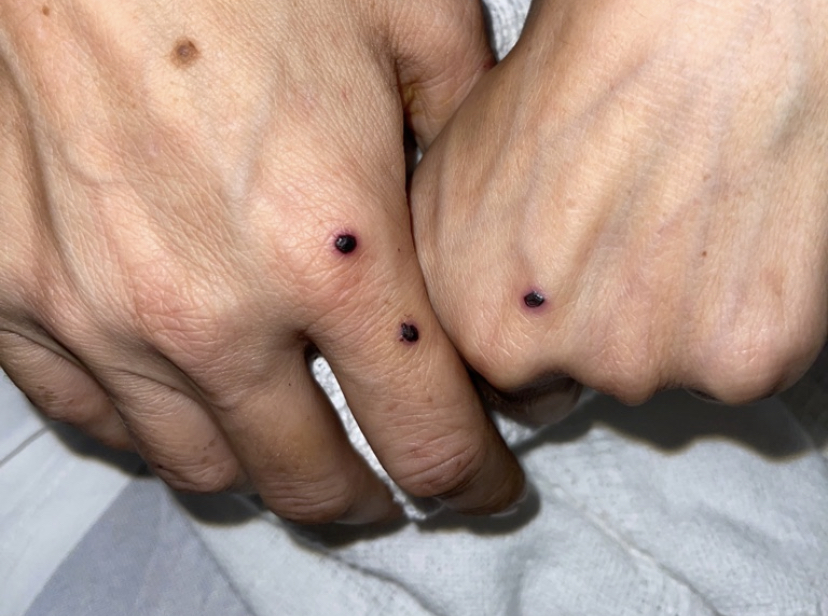Case Presentation: A 32-year-old healthy female presented with right lower quadrant abdominal pain, hematuria, and easy bruising for four days. She denied prior episodes and family history. On physical exam, she had stable vital signs, gingival bleeding, and hemorrhagic papules on her hands [image 1] and lip. Her labs were significant for: hemoglobin 11 g/dL, INR >8.5, PT >110 sec, and PTT 62.7 sec. Platelets, fibrinogen, haptoglobin, and urine drug screen unremarkable. A computerized tomography showed a 4cm hemorrhagic right ovarian cyst. Mixing studies showed correction of coagulopathy. Levels of factors II, VII, IX, X were markedly decreased. Initially, patient denied drug use, however on further questioning, patient reported use of spice (synthetic cannabinoids). The patient was treated with vitamin K for presumed brodifacoum toxicity with normalization of INR. Ultimately, a brodifacoum test was positive. The patient left against medical advice (AMA). Patient was advised to take 50mg vitamin K three times daily (TID) which was sent to her local pharmacy, but she took over the counter vitamin K 100mcg twice a day. Patient returned two weeks later with mucosal bleeding and left lower extremity pain. Labs revealed recurrent coagulopathy. A left lower extremity ultrasound showed a popliteal hematoma. She received transfusions and high dose vitamin K. She was discharged with vitamin K 50mg TID and received a 30-day supply. Patient returned four weeks later with oropharyngeal swelling, mucosal bruising, and bloody sputum. She was intubated due to airway edema. Coagulopathy reoccurred on laboratory evaluation. She was treated with high dose vitamin K, and iron infusions, which she was discharged on.
Discussion: Brodifacoum is a vitamin K antagonist which inhibits the production of coagulation factors II, VII, IX, and X. It is often used as a rodenticide and is known as “superwarfarin”. The effects of brodifacoum can be long lasting. Rodent studies have shown a half-life in the blood of 92 days and a half life in the liver of 307 days1. Clinically, coagulopathy reoccurs without chronic maintenance therapy, with an average duration of therapy of 168 days2. Our patient was the first known case in an outbreak that occurred in Tampa, FL in November 2021. The outbreak included 41 total cases and 2 deaths. A similar incident occurred in the Midwest in 2018 where at least 324 people were poisoned. It is believed that spice may become contaminated when plant materials are inadvertently sprayed during exterminations.
Conclusions: Hospitalists are familiar with the care and treatment of coagulopathy secondary to warfarin. Brodifacoum, while similar to warfarin, is distinct in its duration of effects. It requires prolonged treatment and can result in relapse of the coagulopathy. This need for prolonged treatment is demonstrated in our patient’s case, given her frequent readmissions over eight weeks.Additionally, our patient experienced social barriers to her care. Her INR improved during each admission and worsened after discharge, indicating she was likely not adherent to her treatment. Initially, the prescription was sent after she left AMA. Vitamin K is a costly medication at the required dose. Per GoodRx, the cost for one month is $15,000. This may have been the reason for her non-adherence. However, on subsequent admissions she left with the medications. She did not appear to have a good understanding of the severity of her condition. Medication access and adherence is an area for continued improvement in the care of these patients.

